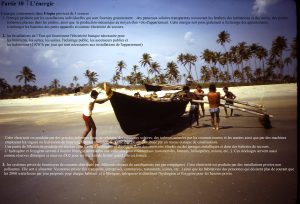Part 10
Energy
The energy consumed in Utopia comes from 3 sources:
-
Individual installations that are provided free of charge: transparent solar panels that cover house windows and greenhouses, small wind turbines in the gardens, as well as the mechanical production by means of an exercise bike.
This energy is mainly used for lighting the apartments, recharging the batteries of small appliances and as emergency electricity.
-
State facilities that provide the basic electricity needed for buildings, greenhouses, factories, street lighting, public elevators and dwellings (2 KW/h per day are required for the facilities of an apartment).
This electricity is produced by large fixed or flying wind turbines, solar panels, turbines animated by sea currents and tides as well as by machines using waves or water pressure at different depths.
This energy is distributed by a state network of pipes. Part of the electricity produced is stored as hydrogen and oxygen in armoured tanks, metal sponges and in backup batteries. Hydrogen and oxygen are used to supply the energy needed for government vehicles (cars, boats, helicopters, planes, etc.). These storages also serve as reserves of energy and reserves of O2 to renew the air in the tower when it is closed.
-
Private supply systems that use piping networks (one per company). This electricity is produced by private, non-polluting facilities. It is used to supply the private economy (transport, businesses, shops, restaurants, factories, etc.), the homes of people who want more power than the 2000 watts/hour per day offered to each inhabitant and to manufacture, store and distribute hydrogen and oxygen for private purposes.
Capitulo 10 : Energia
La energia usada en Utoppia procede de 3 fuentes :
- energia producida por instalaciones individuales, gratis : energia solar (incluyendo vidrio), eolica, mecanica (bicicleta). Esa energia sirve principalmente para cargar aparatos e iluminar las viviendas.
- Instalaciones del estado que disstribuye lo minimo para los huertos, las viviendas, las fábricas, las luces publicas, los transportes. Procede de molinos de viento gigantes sobre los techos de las torres, paneles solares, turbinas que recogen la fuerza de las corrientes… Parte de esa energia sirve para producir hidrogeno oxigeno y con el primero, alimentar los véhiculos publicos ; con el seguno, mejorar el aire ambiente.
- Sistemas privados de produccion de energia, zero contaminacion y recuperacion de basura. Ellos ditribuen toddo lo que pasa del minimo vital.
Visits: 0

